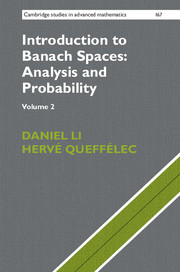Book contents
- Frontmatter
- Dedication
- Contents
- Contents of Volume 1
- Preface
- 1 Euclidean Sections
- 2 Separable Banach Spaces without the Approximation Property
- 3 Gaussian Processes
- 4 Reflexive Subspaces of L1
- 5 The Method of Selectors. Examples of Its Use
- 6 The Pisier Space of Almost Surely Continuous Functions. Applications
- Appendix A News in the Theory of Infinite-Dimensional Banach Spaces in the Past 20 Years
- Appendix B An Update on Some Problems in High-Dimensional Convex Geometry and Related Probabilistic Results
- Appendix C A Few Updates and Pointers
- Appendix D On the Mesh Condition for Sidon Sets
- References
- Notation Index for Volume 2
- Author Index for Volume 2
- Subject Index for Volume 2
- Notation Index for Volume 1
- Author Index for Volume 1
- Subject Index for Volume 1
- References
Appendix B - An Update on Some Problems in High-Dimensional Convex Geometry and Related Probabilistic Results
Published online by Cambridge University Press: 26 October 2017
- Frontmatter
- Dedication
- Contents
- Contents of Volume 1
- Preface
- 1 Euclidean Sections
- 2 Separable Banach Spaces without the Approximation Property
- 3 Gaussian Processes
- 4 Reflexive Subspaces of L1
- 5 The Method of Selectors. Examples of Its Use
- 6 The Pisier Space of Almost Surely Continuous Functions. Applications
- Appendix A News in the Theory of Infinite-Dimensional Banach Spaces in the Past 20 Years
- Appendix B An Update on Some Problems in High-Dimensional Convex Geometry and Related Probabilistic Results
- Appendix C A Few Updates and Pointers
- Appendix D On the Mesh Condition for Sidon Sets
- References
- Notation Index for Volume 2
- Author Index for Volume 2
- Subject Index for Volume 2
- Notation Index for Volume 1
- Author Index for Volume 1
- Subject Index for Volume 1
- References
Summary

- Type
- Chapter
- Information
- Introduction to Banach Spaces: Analysis and Probability , pp. 297 - 306Publisher: Cambridge University PressPrint publication year: 2017

